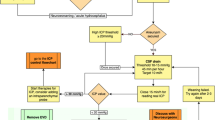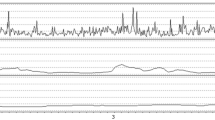Abstract
The time course of intracranial pressure (ICP) after subarachnoid hemorrhage (SAH) is not well known. This retrospective study was conducted to investigate the occurrence and the dynamic variation of raised ICP post-SAH. ICP was prospectively studied in 120 patients with SAH who were admitted to neurocritical care within 24 h of hemorrhage. Patients underwent continuous ICP monitoring for at least 7 days, unless they died. Clinical status on admission, radiographic tests, treatment details and neurological outcome on discharge were analyzed in relation to ICP. The highest daily mean ICP and the day when ICP reduced to normal levels were assessed. Of the 120 patients studied, 112 (93.3 %) encountered ICP elevation whilst in hospital. The daily mean ICP was higher in Hunt and Hess grades IV–V patients than grades I–III patients (P = 0.01). The elevated ICP remained at a higher level for the initial 3 days (grades I–III patients) or 4 days (grades IV–V patients), after which the pressure decreased towards normal levels. The in-patient mortality was significantly increased in the high ICP variability group (P = 0.001), which was divided by the cutoff point using receiver operating characteristic curve analysis. Raised ICP mainly occurs within 8 days post-SAH, especially the initial 3–4 days. Those highlight the need for earlier management of ICP after SAH.







Similar content being viewed by others
References
le Roux AA, Wallace MC (2010) Outcome and cost of aneurysmal subarachnoid hemorrhage. Neurosurg Clin N Am 21(2):235–246
van Gijn J, Kerr RS, Rinkel GJE (2007) Subarachnoid haemorrhage. The Lancet 369(9558):306–318
Cross DT 3rd et al (2003) Mortality rates after subarachnoid hemorrhage: variations according to hospital case volume in 18 states. J Neurosurg 99(5):810–817
Hutchinson PJ, Seeley HM, Kirkpatrick PJ (1998) Factors implicated in deaths from subarachnoid haemorrhage: are they avoidable? Br J Neurosurg 12(1):37–40
Chaudhary SR et al (2008) Prospective evaluation of multidetector-row CT angiography for the diagnosis of vasospasm following subarachnoid hemorrhage: a comparison with digital subtraction angiography. Cerebrovasc Dis 25(1–2):144–150
Ionita CC et al (2010) Timing of symptomatic vasospasm in aneurysmal subarachnoid hemorrhage: the effect of treatment modality and clinical implications. J Stroke Cerebrovasc Dis 19(2):110–115
Lanterna LA, Biroli F (2009) Significance of apolipoprotein E in subarachnoid hemorrhage: neuronal injury, repair, and therapeutic perspectives—a review. J Stroke Cerebrovasc Dis 18(2):116–123
Ryttlefors M et al (2007) Secondary insults in subarachnoid hemorrhage: occurrence and impact on outcome and clinical deterioration. Neurosurgery. 61(4):704–714 (discussion 714–715)
Wartenberg KE et al (2006) Impact of medical complications on outcome after subarachnoid hemorrhage. Crit Care Med 34(3):617–623 (quiz 624)
Hayashi M et al (1984) Cerebral blood flow and ICP patterns in patients with communicating hydrocephalus after aneurysm rupture. J Neurosurg 61(1):30–36
Jagersberg M et al (2010) Simultaneous bedside assessment of global cerebral blood flow and effective cerebral perfusion pressure in patients with intracranial hypertension. Neurocrit Care 12(2):225–233
Nagel A et al (2009) Relevance of intracranial hypertension for cerebral metabolism in aneurysmal subarachnoid hemorrhage. Clinical article. J Neurosurg 111(1):94–101
Sarrafzadeh AS et al (2005) Cerebral metabolism and intracranial hypertension in high grade aneurysmal subarachnoid haemorrhage patients. Acta Neurochir Suppl 95:89–92
Fukuhara T et al (1998) Relationship between intracranial pressure and the development of vasospasm after aneurysmal subarachnoid hemorrhage. Neurol Med Chir (Tokyo) 38(11):710–715 (discussion 716–717)
Mendelow AD (1988) Pathophysiology of delayed ischaemic dysfunction after subarachnoid haemorrhage: experimental and clinical data. Acta Neurochir Suppl (Wien) 45:7–10
Mak CH, Lu YY, Wong GK (2013) Review and recommendations on management of refractory raised intracranial pressure in aneurysmal subarachnoid hemorrhage. Vasc Health Risk Manag 9:353–359
Hirashima Y et al (2003) Independent predictors of late hydrocephalus in patients with aneurysmal subarachnoid hemorrhage—analysis by multivariate logistic regression model. Cerebrovasc Dis 16(3):205–210
Rosenberg JB et al (2011) Non-invasive methods of estimating intracranial pressure. Neurocrit Care 15(3):599–608
Rajajee V et al (2011) Optic nerve ultrasound for the detection of raised intracranial pressure. Neurocrit Care 15(3):506–515
Zhao YL, Zhou JY, Zhu GH (2005) Clinical experience with the noninvasive ICP monitoring system. Acta Neurochir Suppl 95:351–355
Gumerlock MK, York D, Durkis D (1994) Visual evoked responses as a monitor of intracranial pressure during hyperosmolar blood-brain barrier disruption. Acta Neurochir Suppl (Wien) 60:132–135
Burrows FA et al (1990) Anterior fontanel pressure and visual evoked potentials in neonates and infants undergoing profound hypothermic circulatory arrest. Anesthesiology 73(4):632–636
Kesler A et al (2009) Visual evoked potentials in idiopathic intracranial hypertension. Clin Neurol Neurosurg 111(5):433–436
Zhong JI et al (2012) Realization of a comprehensive non-invasive detection of intracranial pressure analyzer based upon FVEP and TCD. Acta Neurochir Suppl 114:127–129
York DH et al (1981) Relationship between visual evoked potentials and intracranial pressure. J Neurosurg 55(6):909–916
York D et al (1984) Further studies with a noninvasive method of intracranial pressure estimation. Neurosurgery 14(4):456–461
Diringer MN et al (2011) Critical care management of patients following aneurysmal subarachnoid hemorrhage: recommendations from the Neurocritical Care Society’s Multidisciplinary Consensus Conference. Neurocrit Care 15(2):211–240
Steiner T et al (2013) European Stroke Organization guidelines for the management of intracranial aneurysms and subarachnoid haemorrhage. Cerebrovasc Dis 35(2):93–112
Stocchetti N et al (2007) Time course of intracranial hypertension after traumatic brain injury. J Neurotrauma 24(8):1339–1346
Heuer GG et al (2004) Relationship between intracranial pressure and other clinical variables in patients with aneurysmal subarachnoid hemorrhage. J Neurosurg 101(3):408–416
Marshall SA et al (2013) Management of intracerebral pressure in the neurosciences critical care unit. Neurosurg Clin N Am 24(3):361–373
Ngo QN et al (2009) External ventricular drains in pediatric patients. Pediatr Crit Care Med 10(3):346–351
Xie X et al (2013) Noninvasive intracranial pressure estimation by orbital subarachnoid space measurement: the Beijing Intracranial and Intraocular Pressure (iCOP) study. Crit Care 17(4):R162
Voldby B et al (1982) Intracranial pressure changes following aneurysm rupture: clinical and angiographic correlations. J Neurosurg 56:186–196
Holsgrove DT et al (2014) Intracranial hypertension in subarachnoid hamorrhage: outcome after decompressive craniectomy. Acta Neurochir Suppl 119:53–55
Lai H-Y et al (2010) The intracranial volume pressure response in increased intracranial pressure patients: part 1. Calculation of the volume pressure indicator. Acta Neurochir 154(12):2271–2275
Lu H et al (2009) Expression of monocyte chemoattractant protein-1 in the cerebral artery after experimental subarachnoid hemorrhage. Brain Res 1262:73–80
Kosteljanetz M (1984) CSF dynamics in patients with subarachnoid and/or intraventricular hemorrhage. J Neurosurg 60(5):940–946
Ayer R, Zhang J (2010) Connecting the early brain injury of aneurysmal subarachnoid hemorrhage to clinical practice. Turk Neurosurg 20(2):159–166
Lu J et al (2012) Prognosis and treatment of acute hydrocephalus following aneurysmal subarachnoid haemorrhage. J Clin Neurosci 19(5):669–672
Claassen J et al (2002) Global cerebral edema after subarachnoid hemorrhage: frequency, predictors, and impact on outcome. Stroke 33(5):1225–1232
Janjua N, Mayer SA (2003) Cerebral vasospasm after subarachnoid hemorrhage. Curr Opin Crit Care 9(2):113–119
Gambardella G et al (1998) Intracranial pressure, cerebral perfusion pressure, and SPECT in the management of patients with SAH Hunt and Hess grades I–II. Acta Neurochir Suppl 71:215–218
Groden C et al (2001) Comparison of operative and endovascular treatment of anterior circulation aneurysms in patients in poor grades. Neuroradiology 43(9):778–783
Acknowledgments
This work was supported by grants from National Natural Science Fund (No. 811014 73) and the Fund of Chinese Education Department (No. 20115503120008).
Conflict of interest
The Authors declare that there is no conflict of interest.
Author information
Authors and Affiliations
Corresponding author
Rights and permissions
About this article
Cite this article
Lv, Y., Wang, D., Lei, J. et al. Clinical observation of the time course of raised intracranial pressure after subarachnoid hemorrhage. Neurol Sci 36, 1203–1210 (2015). https://doi.org/10.1007/s10072-015-2073-9
Received:
Accepted:
Published:
Issue Date:
DOI: https://doi.org/10.1007/s10072-015-2073-9




